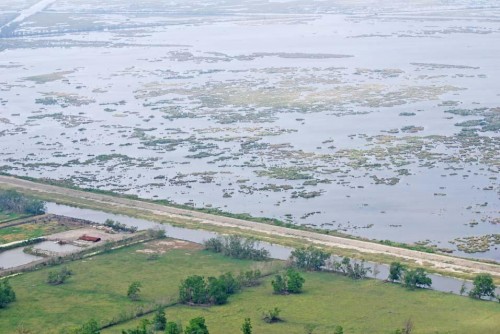
Irvin J. "Black" Landry Sr.
April 28, 2009Curt John Ordoyne
April 30, 2009Louisiana’s eroding coastline could be saved by directing fresh Mississippi River water to build up wetlands, said University of New Orleans environmental sciences professor Denise Reed at last week’s South Central Industrial Association meeting in Houma.
Even in a worst-case scenario, around 701 square kilometers of land could be built up using water from the Mississippi, according to Reed.
“We need to promote a sustainable coastal ecosystem by harnessing the processes of the natural system,” she told SCIA members. “Route riverine waters through estuarine basins.”
Reed has worked at the Louisiana Universities Marine Consortium in Cocodrie. She was one of eight members of the Morganza Technical Review Panel, composed mostly of scientists, that made recommendations to the state last year concerning the building of the Morganza-to-the-Gulf hurricane levee system.
Reed said land erosion along the Louisiana coast has slowed down a bit, but the problem is still huge.
“(South Terrebonne) is an important area, but not many know what goes on down here,” she said.
One of the main causes of wetland loss is well-known: Using levees to force the Mississippi River to continue flowing past New Orleans has deprived the rest of the Louisiana coast of the river’s precious land-building sediment. Around 120 million tons of Mississipi River sediment each year are funneled into the Gulf of Mexico.
The Lafourche and Terrebonne deltas that jut into the gulf today were deltas of the Mississippi River several thousand years ago. The Bayou Terrebonne ridge is at least 4,000 years old, which is young-geologically speaking.
“The mud in the river built the land,” Reed said. “The older deltas are deteriorating.”
The state’s Coastal Protection and Restoration Authority is taking a piecemeal approach, she said.
The solution is to stop wasting the river’s sediment, especially since the amount of mud in the river is dropping.
“We need to direct it into shallow coastal areas where we can build packages of sediments,” she said. “Mud in the river is our most valuable resource. It’s worth more than money.”
Reed cited other concerns. Morganza-to-the Gulf is not intended to restore wetlands, only to protect Terrebonne from storm surge.
Wetlands will still have to be restored inside the system, she said.
Navigation on the Mississippi River also has to be sustained, she said. Unlike coastal restoration and protection, navigation is not under the purview of the state.
But Reed’s focus is on how well coastal marshes are keeping pace with sea level.
At a 2006 conference of the Technical Group for Envisioning the Future of the Gulf Coast, representatives from the flood-prone Venice, Italy; the Netherlands, and the Nile Delta, were asked about what could be done for the Louisiana coast.
According to Reed, the answer given was: “If you carry on the way you are, the future is bleak.”
“We need to maximize the use of the Mississippi River,” she concluded.
Fresh water introduced from the Mississippi River could be the key to rebuilding land lost to the encroaching salt water of the Gulf of Mexico, such as the eroding marsh seen in this photo of south Terrebonne Parish. * Photo by KEYON K. JEFF








